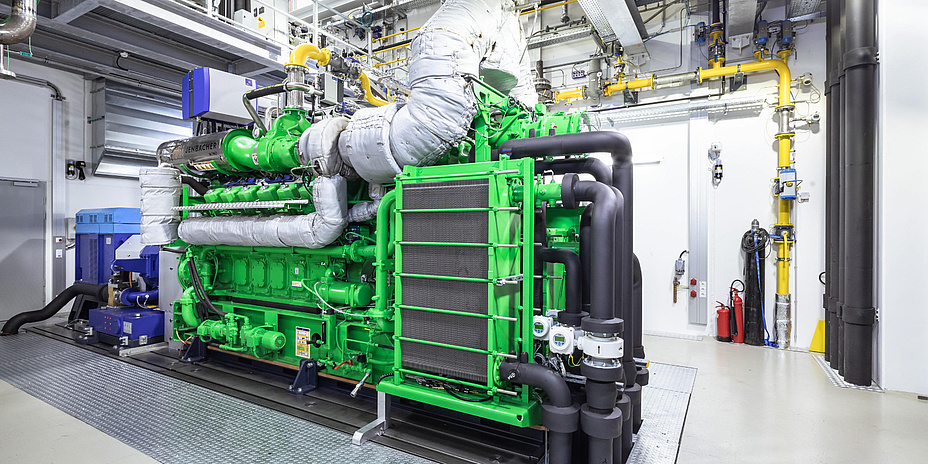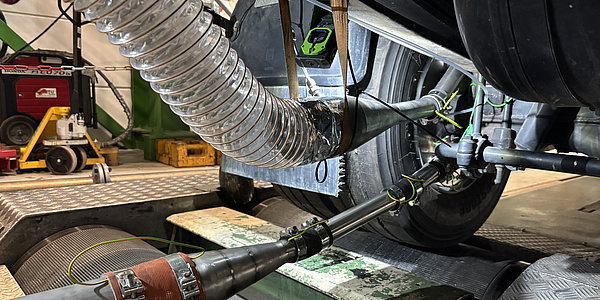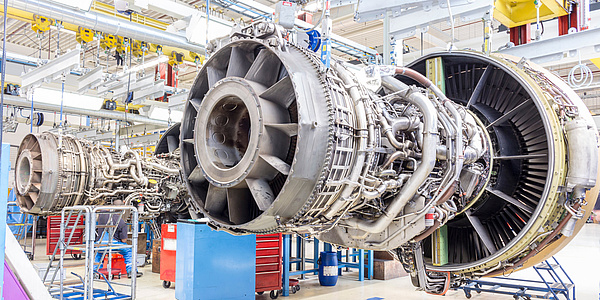New fuels for climate-neutral marine transportation

News + Stories: For a long time, ship engines have had a bad reputation as notorious polluters, but a great deal has improved in recent years. What’s behind this change, and how will ship engines become even more sustainable in the future?
Nicole Wermuth: Developments in recent years have been strongly driven by stricter requirements issued by the IMO – the International Maritime Organization: as a case in point, the maximum permissible sulphur content for marine fuel was cut from 3.5 to 0.5 percent. Heavy fuel oil with a higher sulphur content can only be used as a fuel if supplementary exhaust gas cleaning systems for sulphur oxides are in place. Ambitious targets have also been set when it comes to increasing efficiency and lowering fuel consumption. Both of which can be achieved not only through changes in propulsion, but also thanks to measures such as "slow steaming" and optimised route planning, which require less propulsion power. Another factor is changes to the ship's hull, which can include the application of special coatings or the use of more intensive cleaning routines. All of these measures are low-hanging fruit, and together they add up to double-digit savings.
Andreas Wimmer: That's correct, but even so these measures are only capable of cutting carbon dioxide emissions by up to 20%. To help meet climate goals – the aim for the marine sector is to eliminate greenhouse gas emissions completely by 2050 – we will need to achieve reductions of 95% or more! And this will only be possible if we switch to climate-neutral fuels. With this in mind, the LEC (Large Engines Competence Center) is conducting extensive research into the use of green fuels for use in sustainable energy and transport systems within the framework of the COMET K1 program LEC GETS (Green Energy and Transportation Systems) in partnership with the Institute for Thermodynamics and Sustainable Propulsion Systems at TU Graz and other renowned science and industry partners. For the most part, the experimental investigations are being carried out on the LEC’s unique test rig infrastructure, which has been built up over many years at TU Graz Campus Inffeldgasse.
Are old ship engines suitable for new fuels?
Andreas Wimmer: Unfortunately not. Depending on the type of fuel, they will require major modifications and these can be very complex indeed. That said, the engines that are being delivered right now are already taking future retrofitting into account, which is a very positive development in terms of sustainable use of resources. As a result, we are also focusing on retrofit solutions for particularly long-lasting applications within the COMET LEC GETS program.
Methanol, ammonia, and hydrogen are being touted as new fuels for shipping. Which is the favourite?
Nicole Wermuth: Some say methanol, others ammonia. It can be assumed that methanol will remain more expensive than ammonia. This means that ammonia could win out, especially in price-sensitive shipping segments, in spite of concerns about toxicity. In the cruise sector, where a large number of people could be affected in the event of a system failure, operators are more cautious and tend to favour methanol as a result. Ammonia is more likely to be used as a fuel on container ships, where there are only a small number of people on board who can also be given the appropriate risk training.
Andreas Wimmer: Generally speaking, ammonia is seen as an efficient storage medium for hydrogen. Which means that it is also very suitable for transporting energy – especially renewable carriers from energy surplus regions such as Australia, South America, and Africa. A large proportion of these energy transports will take place by ship, going forward. And if you already have ammonia on board anyway, it makes sense to use it for propulsion, too. This is exactly how gas engines became established in shipping, in line with the significant rise in marine transport of liquefied natural gas – LNG – over the past few decades.
This ultimately led to the development of what are known as dual-fuel engines, which run on both natural gas and diesel. When gas is used as the primary fuel, small amounts of diesel are used to initiate ignition. Meanwhile, highly robust diesel operation serves as a backup in an emergency, as reliability of propulsion is absolutely essential in the marine sector. Dual-fuel solutions such as these are also suitable for the new fuels.
Why is diesel so much more reliable?
Andreas Wimmer: Because the underlying principle is extremely simple: you compress the air, inject fuel, and the propulsion system gets to work – even under the harshest of conditions. Gas engines, by contrast, are far more complex, especially in terms of engine control. And when it comes to ammonia, additional components such as an ammonia cracker are required. This results in a highly complex system on board – which can be much more failure-prone overall.
What is the difference between a large engine that runs on ammonia and its conventional counterpart?
Nicole Wermuth: As already mentioned, we will largely see dual-fuel engines featuring diesel pilot ignition in the shipping sector. For power generation, it is more likely that spark-ignition combustion processes will be used in ammonia engines. However, the engines will need an additional ignition improver given that ammonia is about 50 times harder to ignite than natural gas. To overcome this, a small amount of the ammonia must be chemically split so that it burns more easily – we refer to this as "cracked" ammonia. This "cracker gas" has to be fed into the engine in a controlled manner, meaning that an ammonia engine requires additional dosing, mixing, and control devices as a result. As ammonia is highly corrosive, components have to be checked for their compatibility with ammonia and all of the materials in the engine system have to be designed accordingly.
Exhaust gas aftertreatment is a very important point: in the case of ammonia this means aftertreatment of nitrogen oxide in the exhaust gas. When ammonia is burned, significantly more nitrogen oxide is produced than when natural gas is burned. Established technologies for nitrogen oxide reduction such as those used in vehicles or other power plant systems will be used in aftertreatment.
Mr. Wimmer, you are also leading a research project into CO2 capture on board of ships. Is the use of this technology a realistic way to make shipping more sustainable?
Andreas Wimmer: In conjunction with ongoing use of fossil fuels, we view it as a transitional technology that will have a certain role to play in the years to come. Depending on the process, CO2 capture rates ranging from 40-80% are achievable. One problem is that the captured CO2 has to be stored on board the ship and transported back to port for unloading. When diesel fuel is burned, by mass about three times as much CO2 is produced. This means that even if the diesel tanks could be used for CO2 storage, additional tanks would need to be installed, and this causes higher costs as well as taking up more space. As a result, some people say that capture rates should be capped at 30%.
Are on-board carbon capture technologies similar to the ones used in land-based systems?
Andreas Wimmer: There are now a variety of carbon capture processes out there, many of which are new and could potentially be used for shipping and are currently under development. The amine scrubbing process – standard in the power plant sector – is also suitable for the shipping sector.
Let's turn to methanol now: it’s easier to handle than both ammonia and hydrogen – so why isn’t it used everywhere?
Nicole Wermuth: In reality, there are some ships that are already running on methanol. But the big challenge, however, is that methanol contains carbon and produces CO2 when it is burned. This means that things only become truly sustainable when green methanol is used – i.e. when the carbon contained in the methanol isn’t from fossil sources. There are basically two approaches: besides bio-methanol (where the CO2 cycle is closed via plants or trees), e-methanol can be used. The CO2 needed to produce e-methanol is taken either directly from the ambient air, which is an energy-intensive process, or retained in the cycle through the application of various carbon capture technologies. While the main disadvantage of bio-methanol is competition with food production, what all methods of producing e-methanol have in common is that they are relatively complex. As things currently stand, it looks as though methanol will be more expensive as a fuel than ammonia as a consequence.
In terms of the engines themselves, using methanol as a fuel isn’t a major challenge?
Nicole Wermuth: Well, it does involve a certain amount of effort: pure methanol is not suitable for compression ignition. The diesel fuel required for this is fed in via a separate injector. In fact, multiple injectors are needed: one for the methanol and another for the diesel. While the technology for this is somewhat complex, it’s not entirely unfamiliar.
What about hydrogen - isn't it actually too valuable to just burn it?
Andreas Wimmer: My underlying belief is that green hydrogen should be used first and foremost in applications where large carbon-saving effects can be achieved very quickly. I take a rather more critical view of the widespread use of hydrogen in the mobility sector, as this would call for extensive infrastructure measures. In the marine sector, hydrogen propulsion is particularly interesting if the vessels are also intended for the transport of hydrogen. However, combustion processes for hydrogen are far from simple.
What are the differences?
Andreas Wimmer: Generally speaking, you could say that the use of methanol as a fuel is easier to manage compared with hydrogen and ammonia. In addition to its corrosiveness, ammonia burns relatively poorly and special measures have to be taken to develop a suitable combustion process. Hydrogen, meanwhile, is easily ignitable and burns very quickly. This, though, can lead to premature ignition, which is detrimental to efficient engine operation. The process is very challenging overall, and a great deal of development work is still needed before it can be applied reliably.
This research is anchored in the Fields of Expertise “Mobility & Production” and “Sustainable Systems”, two strategic foci of TU Graz.
Since the 1990s, Graz has been home to world-renowned research in the field of large engines.
The Institute for Thermodynamics and Sustainable Propulsion Systems (ITnA) at TU Graz and the Large Engines Competence Center (LEC) are working together on the development of sustainable energy and transport systems and thus on the decarbonization of this sector.
While the institute is dedicated to basic research and teaching, the LEC conducts application-oriented research, in particular within the framework of the COMET K1 research program LEC GETS (Green Energy and Transportation Systems), the results of which flow directly into teaching. The necessary experimental investigations are largely carried out at the LEC's unique test bench infrastructure on Campus Inffeldgasse of TU Graz. In addition to paid scientific work on exciting topics, students also have access to interesting career paths in large engine research at the Graz site.
You can find more research news on Planet research. Monthly updates from the world of science at Graz University of Technology are available via the research newsletter TU Graz research monthly.
Kontakt
Nicole WERMUTH
Univ.-Prof. Dr.-Ing.
TU Graz | Institute for Thermodynamics and Sustainable Propulsion Systems; CSO LEC GmbH
Phone: +43 (0)316 873 30087
nicole.wermuth@tugraz.at
Andreas WIMMER
Ao.Univ.-Prof. Dipl.-Ing. Dr.techn.
TU Graz | Institute for Thermodynamics and Sustainable Propulsion Systems
Phone: +43 (0)316 873 30100
wimmer@tugraz.at




